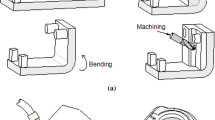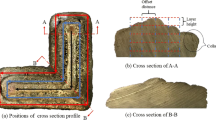Abstract
To meet lightweight demands, complex support or near-net shaped structures are increasingly applied in modern industry sectors. Wire arc additive manufacturing (WAAM) of these structures requires a profound knowledge of the interactions between material properties, welding process and mechatronic engineering. This study shows a new WAAM strategy, termed skeleton arc additive manufacturing (SAAM), adapted especially for building freeform wire-structured aluminium component, and further contributes a bead modelling study to establish welding parameters, geometric features and material properties relationship. The results show that good geometrical features and sound metallurgical properties can be achieved for wire-structure aluminium parts using the proposed approach. The strut diameter gradually increased with the amplified welding arc-on time and wire feed speed; however, they present significant changes in the microstructural evolution and mechanical strength. A sample demonstration further displays an effective path to create typically wire-structure part with good quality and offers the main processing challenge and coping strategy during SAAM.



















Similar content being viewed by others
Availability of data and materials
The datasets used or analysed during the current study are available from the corresponding author on reasonable request.
References
Ford S, Despeisse M (2016) Additive manufacturing and sustainability: an exploratory study of the advantages and challenges. J Clean Prod 137:1573–1587
Mezzadri F, Bouriakov V, Qian X (2018) Topology optimization of self-supporting support structures for additive manufacturing. Addit Manuf 21:666–682
Gao W, Zhang Y, Ramanujan D, Ramani K, Chen Y, Williams CB, Wang CCL, Shin YC, Zhang S, Zavattieri PD (2015) The status, challenges, and future of additive manufacturing in engineering. Comput Aided Des 69:65–89
Calignano F (2014) Design optimization of supports for overhanging structures in aluminum and titanium alloys by selective laser melting. Mater Des 64:203–213
Vaidya R, Anand S (2016) Optimum Support Structure Generation for Additive Manufacturing Using Unit Cell Structures and Support Removal Constraint. Procedia Manuf 5:1043–1059
Williams SW, Martina F, Addison AC, Ding J, Pardal G, Colegrove P (2016) Wire + Arc Additive Manufacturing. Mater Sci Technol 32(7):641–647
D.H. Ding, Z.X. Pan, C. Dominic, H.J. Li, Process Planning Strategy for Wire and Arc Additive Manufacturing, Robotic Welding, Intelligence and Automation, Springer2015, pp. 437-450.
Wu B, Pan Z, Ding D, Cuiuri D, Li H, Xu J, Norrish J (2018) A review of the wire arc additive manufacturing of metals: properties, defects and quality improvement. J Manuf Process 35:127–139
Yu Z, Yuan L, He F, Ding D, Polden J and Pan Z (2019) The Strategy for Fabricating Wire-Structure Parts Using Robotic Skeleton Arc Additive Manufacturing, 2019 IEEE 9th Annual International Conference on CYBER Technology in Automation, Control, and Intelligent Systems (CYBER), Suzhou, China, pp. 119-124.
Zhang H, Huang J, Liu C, Ma Y, Han* Y, Xu T, Lu J and Fang H (2020) Fabricating Pyramidal Lattice Structures of 304 LStainless Steel by Wire Arc Additive Manufacturing, Materials 16:3482.
Xu T, Tang S, Liu C, Li Z, Fan H, Ma S (2020) Obtaining large-size pyramidal lattice cell structures by pulse wire arc additive manufacturing. Mater Des 187:108401
Abe T, Sasahara H (2019) Layer geometry control for the fabrication of lattice structures by wire and arc additive manufacturing. Addit Manuf 28:639–648
Li Y, Yu S, Chen Y, Yu R, Shi Y (2020) Wire and arc additive manufacturing of aluminum alloy lattice structure. J Manuf Process 50:510–519
Wu B, Ding D, Pan Z, Cuiuri D, Li H, Han J, Fei Z (2017) Effects of heat accumulation on the arc characteristics and metal transfer behavior in Wire Arc Additive Manufacturing of Ti6Al4V. J Mater Process Technol 250:304–312
Brandl E, Schoberth A, Leyens C (2012) Morphology, microstructure, and hardness of titanium (Ti-6Al-4 V) blocks deposited by wire-feed additive layer manufacturing (ALM). Mater Sci Eng A 532:295–307
Miao Q, Wu D, Chai D, Zhan Y, Bi G, Niu F, Ma G (2020) Comparative study of microstructure evaluation and mechanical properties of 4043 aluminum alloy fabricated by wire-based additive manufacturing. Mater Des 186:108205
Wei HL, Elmer JW, DebRoy T (2016) Origin of grain orientation during solidification of an aluminum alloy. Acta Mater 115:123–131
Wu B, Pan Z, Ding D, Cuiuri D, Li H (2018) Effects of heat accumulation on microstructure and mechanical properties of Ti6Al4V alloy deposited by wire arc additive manufacturing. Addit Manuf 23:151–160
Inoue T, Horita Z, Somekawa H, Ogawa K (2008) Effect of initial grain sizes on hardness variation and strain distribution of pure aluminum severely deformed by compression tests. Acta Mater 56(20):6291–6303
A. International, ASTM E1648-15, Standard Reference Radiographs for Examination of Aluminum Fusion Welds, www.astm.org, West Conshohocken, PA,, 2015.
Ahmad R, Bakar M (2011) Effect of a post-weld heat treatment on the mechanical and microstructure properties of AA6061 joints welded by the gas metal arc welding cold metal transfer method. Mater Des 32(10):5120–5126
Haselhuhn AS, Buhr MW, Wijnen B, Sanders PG, Pearce JM (2016) Structure-property relationships of common aluminum weld alloys utilized as feedstock for GMAW-based 3-D metal printing. Mater Sci Eng A 673:511–523
Bo J, Wang J, Shi J (2015) Microstructure and mechanical properties of 4043 aluminum alloy thin wall parts manufactured by TIG WAAM. Welding 10:23–26
Romano S, Patriarca L, Foletti S, Beretta S (2018) LCF behaviour and a comprehensive life prediction model for AlSi10Mg obtained by SLM. Int J Fatigue 117:47–62
Pal K, Pal SK (2011) Effect of pulse parameters on weld quality in pulsed gas metal arc welding: a review. J Mater Eng Perform 20(6):918–931
Montevecchi F, Venturini G, Grossi N, Scippa A, Campatelli G (2018) Idle time selection for wire-arc additive manufacturing: A finite element-based technique. Addit Manuf 21:479–486
Funding
This paper includes research that was finically supported by DMTC Limited (Australia). The authors have prepared this paper in accordance with the intellectual property rights granted to partners from the original right.
Author information
Authors and Affiliations
Contributions
Bintao Wu carried out the experiment and wrote the manuscript with support from Stephen van Duin. Ziping and Yu performed the deposition strategy for case study. Zengxi Pan and Huijun Li supervised the findings of this work. Edward Pierson supervised the project. All authors provided critical feedback and helped shape the research, analysis and manuscript.
Corresponding authors
Ethics declarations
Ethical approval
Authors promise that this manuscript is original, and it has not been published in whole or in part nor is it being considered for publication or submission elsewhere.
Consent to participate
We make sure the author group, the corresponding author, and the order of authors are all correct at submission.
Consent to publish
The authors have reviewed the present version of the manuscript and approved it for publication.
Competing interests
All authors certify that they have no affiliations with or involvement in any organization or entity with any financial interest or non-financial interest in the subject matter or materials discussed in this manuscript.
Additional information
Publisher’s note
Springer Nature remains neutral with regard to jurisdictional claims in published maps and institutional affiliations.
Rights and permissions
About this article
Cite this article
Wu, B., Pan, Z., Ziping, Y. et al. Robotic skeleton arc additive manufacturing of aluminium alloy. Int J Adv Manuf Technol 114, 2945–2959 (2021). https://doi.org/10.1007/s00170-021-07077-4
Received:
Accepted:
Published:
Issue Date:
DOI: https://doi.org/10.1007/s00170-021-07077-4




